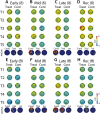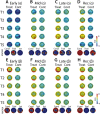Habituation of the stress response multiplex to repeated cold pressor exposure
- PMID: 36703933
- PMCID: PMC9871365
- DOI: 10.3389/fphys.2022.752900
Habituation of the stress response multiplex to repeated cold pressor exposure
Abstract
Humans show remarkable habituation to aversive events as reflected by changes of both subjective report and objective measures of stress. Although much experimental human research focuses on the effects of stress, relatively little is known about the cascade of physiological and neural responses that contribute to stress habituation. The cold pressor test (CPT) is a common method for inducing acute stress in human participants in the laboratory; however, there are gaps in our understanding of the global state changes resulting from this stress-induction technique and how these responses change over multiple exposures. Here, we measure the stress response to repeated CPT exposures using an extensive suite of physiologic measures and state-of-the-art analysis techniques. In two separate sessions on different days, participants underwent five 90 s CPT exposures of both feet and five warm water control exposures, while electrocardiography (ECG), impedance cardiography, continuous blood pressure, pupillometry, scalp electroencephalography (EEG), salivary cortisol and self-reported pain assessments were recorded. A diverse array of adaptive responses are reported that vary in their temporal dynamics within each exposure as well as habituation across repeated exposures. During cold-water exposure there was a cascade of changes across several cardiovascular measures (elevated heart rate (HR), cardiac output (CO) and Mean Arterial Pressure (MAP) and reduced left ventricular ejection time (LVET), stroke volume (SV) and high-frequency heart rate variability (HF)). Increased pupil dilation was observed, as was increased power in low-frequency bands (delta and theta) across frontal EEG electrode sites. Several cardiovascular measures also habituated over repeated cold-water exposures (HR, MAP, CO, SV, LVET) as did pupil dilation and alpha frequency activity across the scalp. Anticipation of cold water induced stress effects in the time-period immediately prior to exposure, indexed by increased pupil size and cortical disinhibition in the alpha and beta frequency bands across central scalp sites. These results provide comprehensive insight into the evolution of a diverse array of stress responses to an acute noxious stressor, and how these responses adaptively contribute to stress habituation.
Keywords: EEG; adaptation; cardiac physiology; cold pressor; habituation; pupillometry; repeated exposure; stress.
Copyright © 2023 Bullock, MacLean, Santander, Boone, Babenko, Dundon, Stuber, Jimmons, Raymer, Okafor, Miller, Giesbrecht and Grafton.
Conflict of interest statement
The authors declare that the research was conducted in the absence of any commercial or financial relationships that could be construed as a potential conflict of interest.
Figures












Similar articles
-
Stress responses to repeated exposure to a combined physical and social evaluative laboratory stressor in young healthy males.Psychoneuroendocrinology. 2016 Jan;63:119-27. doi: 10.1016/j.psyneuen.2015.09.025. Epub 2015 Sep 28. Psychoneuroendocrinology. 2016. PMID: 26441230
-
Cold pressor stress effects on cardiac repolarization.Stress. 2024 Jan;27(1):2352626. doi: 10.1080/10253890.2024.2352626. Epub 2024 May 20. Stress. 2024. PMID: 38766757
-
The socially evaluated cold-pressor test (SECPT) for groups: effects of repeated administration of a combined physiological and psychological stressor.Psychoneuroendocrinology. 2014 Jul;45:119-27. doi: 10.1016/j.psyneuen.2014.03.022. Epub 2014 Apr 8. Psychoneuroendocrinology. 2014. PMID: 24845183 Clinical Trial.
-
Human cold habituation: Physiology, timeline, and modifiers.Temperature (Austin). 2021 May 25;9(2):122-157. doi: 10.1080/23328940.2021.1903145. eCollection 2022. Temperature (Austin). 2021. PMID: 36106151 Free PMC article. Review.
-
Water temperature during the cold pressor test: A scoping review.Physiol Behav. 2023 Nov 1;271:114354. doi: 10.1016/j.physbeh.2023.114354. Epub 2023 Sep 17. Physiol Behav. 2023. PMID: 37717684 Review.
Cited by
-
Cardiovascular and Ocular Parameter Alterations in Response to Cold Pressor Test in Young Adults.Diagnostics (Basel). 2024 Sep 11;14(18):2010. doi: 10.3390/diagnostics14182010. Diagnostics (Basel). 2024. PMID: 39335689 Free PMC article.
-
Using Electrooculography and Electrodermal Activity During a Cold Pressor Test to Identify Physiological Biomarkers of State Anxiety: Feature-Based Algorithm Development and Validation Study.JMIRx Med. 2025 Jul 10;6:e69472. doi: 10.2196/69472. JMIRx Med. 2025. PMID: 40638808 Free PMC article.
-
Impedance cardiogram based exploration of cardiac mechanisms in post-traumatic stress disorder during trauma recall.Psychophysiology. 2024 Apr;61(4):e14488. doi: 10.1111/psyp.14488. Epub 2023 Nov 20. Psychophysiology. 2024. PMID: 37986190 Free PMC article.
-
Quantifying Posttraumatic Stress Disorder Symptoms During Traumatic Memories Using Interpretable Markers of Respiratory Variability.IEEE J Biomed Health Inform. 2024 Aug;28(8):4912-4924. doi: 10.1109/JBHI.2024.3397589. Epub 2024 Aug 6. IEEE J Biomed Health Inform. 2024. PMID: 38713564 Free PMC article.
-
Bystander Acknowledgment Mitigates the Psychological and Physiological Pain of Racial Discrimination for Black Young Adults: A Randomized Controlled Trial.J Pain. 2024 Sep;25(9):104560. doi: 10.1016/j.jpain.2024.104560. Epub 2024 May 11. J Pain. 2024. PMID: 38735424 Clinical Trial.
References
LinkOut - more resources
Full Text Sources
Research Materials
Miscellaneous

